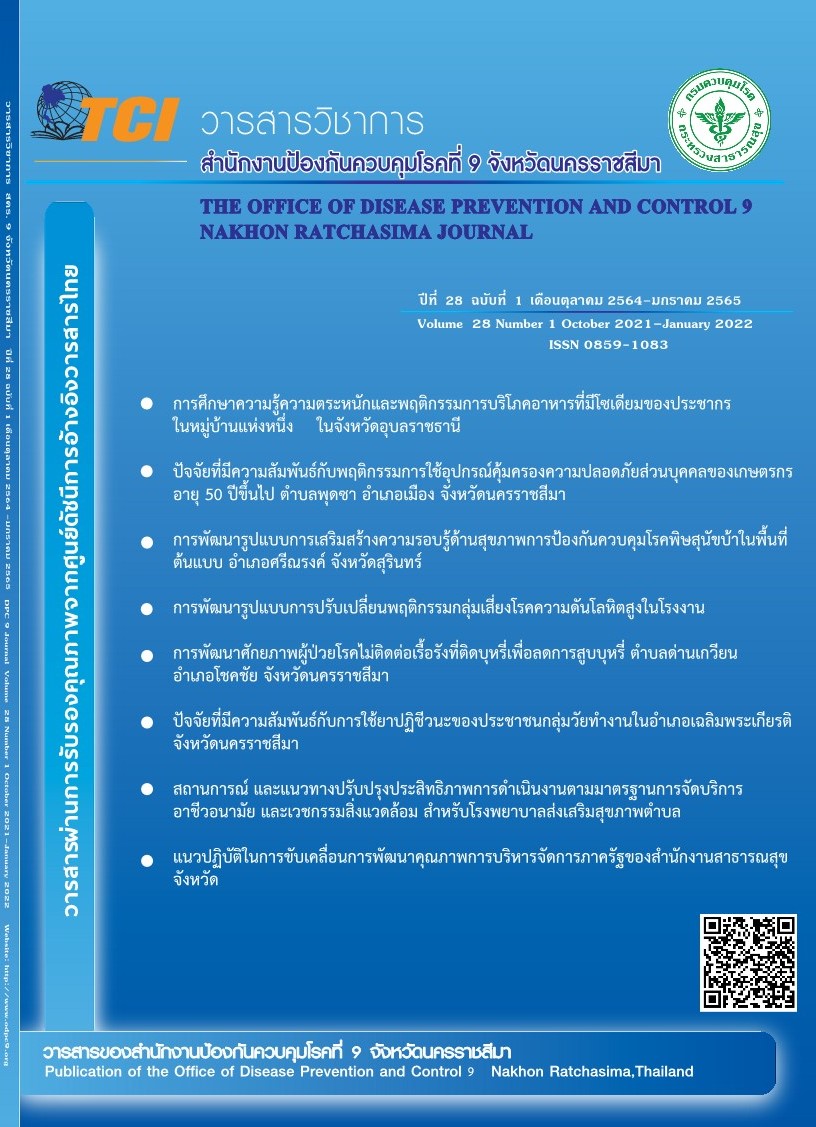A study to assess knowledge, awareness, and sodium consumption behavior among hypertensive patients with diabetes mellitus and population without diabetes mellitus in Kham Nang Ruai Tai Village, Village No. 7, Kham Nam Saep Subdistrict, Warin Chamrap District Ubon Ratchathani Province.
การศึกษาความรู้ ความตระหนักและพฤติกรรมการบริโภคอาหารที่มีโซเดียมของประชากรในเขตหมู่บ้านคำนางรวยใต้หมู่7 ตำบลคำน้ำแซบ อำเภอวารินชำราบ จังหวัดอุบลราชธานี
Keywords:
Knowledge, Awareness, Behavior of sodium food consumption, CKDAbstract
The problem of chronic kidney disease (CKD) is likely to increase continuously. Raising awareness of the population about how to reduce high-sodium food consumption behavior is the way to reduce this problem. This research aims to study the knowledge, awareness, and behavior of sodium food consumption. Random sampling was conducted for collecting data including over 30-years people who actually live in Kham Nang Ruay Tai village, moo. 7, Kham Nam Zap sub-district, Warin Chamrap district, Ubon Ratchathani province, a total of 122 people was collected the data by using a general information questionnaire, knowledge and awareness questionnaire about salt and sodium intake, sodium consumption behavior. Descriptive statistics; the validity of questionnaires was CVI: 0.95, 0.80, 0.81 respectively. The reliability of knowledge and awareness questionnaires was shown with Alpha Cronbach = 0 .72 and 0.70 respectively. The data were analyzed by frequency, percentage, mean, and standard deviation. Comparing the difference of mean was done by independent t-test statistics. The results were as follows: 1) The knowledge and awareness about salt and sodium consumption was 46.30% (low level). knowledge and awareness of the participants who had diabetes and hypertension were 55.53%, which was greater than the non-diabetes, non-hypertension persons (45.53%). T-test statistics used to analyze the average knowledge awareness of two groups (= 1.41, S.D. = 0.46, = 1.45, S.D. = 0.46). There were no statistical differences between groups 2) The average sodium consumption behavior in both groups was at a moderate level, there were no statistically different (= 1.96, S.D. = 0.71, = 2.05, S.D. = 0.68). Compared data by t-test statistics of the average individual behavioral differences for both groups found that there was 1 item: Item number 7 indicated that the participants always read the nutrition label for looking the sodium content information (= 2.06, S.D. = 0.96, = 1.54, S.D. = 0.70), there was a statistically significant difference (P-value < 0.05). There are some recommendations: 1) public health providers should be promoted to people to have more knowledge and awareness about reducing sodium consumption. 2) suggestion the consumers about how to read food labels. 3) recommendation specific food for specific patients who need to limit sodium such as diabetes, hypertension and chronic kidney disease, etc., moreover, should study about the factors affecting the behavior of the sodium consumption.
References
Nicola L.D. & Zoccali C. Chronic kidney disease prevalence in the general population: heterogeneity and concerns. Nephrol Dial Transplant 2016; 31: 331-335.
ประเสริฐ ธนกิจจารุ. สถานการณ์ปัจจุบันของโรคไตเรื้อรังในประเทศไทย. วารสารกรมการแพทย์ 2558; 40(5): 5–19.
วรางคณา พิชัยวงศ์. โรคไตจากเบาหวาน. วารสารกรมการแพทย์ 2558; 40(5): 20–25.
ลือชัย ศรีเงินยาง, ชนิตาม วงษ์จินดา และฐนิดา อภิชนะกุลชัย. สถานการณ์การบริโภคเกลือโซเดียมในประเทศไทย. สำนักโรคไม่ติดต่อ กรมควบคุมโรค กระทรวงสาธารณสุข; 2550.
กองสุขศึกษา กรมสนับสนุนบริการสุขภาพ กระทรวงสาธารณสุข. พฤติกรรมการบริโภคหวาน มัน เค็ม [อินเตอร์เนต]. 2556 [เข้าถึงเมื่อ 2562 ธันวาคม 10]. เข้าถึงได้จาก: http://www.hed.go.th.
แพรวพรรณ สุริวงศ์. โซเดียม ภัยร้ายที่ไม่ควรมองข้าม [อินเตอร์เนต]. 2559 [เข้าถึงเมื่อ 2562 ธันวาคม 10]. เข้าถึงได้จาก: https://www.thaihealth.or.th/Content/35967.
Yuko Ohta, Takuya Tsuchihashi, Kanako Kiyohara & Hideyuki Onik. High salt intake promotes a decline in renal function in hypertensive patients: a 10-year observational study. Hypertension Research 2013; 36:172–176.
กองโรคไม่ติดต่อ กระทรวงสาธารณสุข. จำนวนผู้ป่วยรายใหม่เบาหวาน ความดันโลหิตสูง ปีงบประมาณ 2560 แยกตามเขตบริการสาธารณสุข [อินเตอร์เนต]. 2561 [เข้าถึงเมื่อ 2562 ธันวาคม 10]. เข้าถึงได้จาก: http://www.thaincd.com/2016/mission/documents-detail.php?id=13893&tid=32&gid=1-020.
Daniel W.W. Biostatistics: Basic Concepts and Methodology for the Health Sciences, 9th ed. New York: John Wiley & Sons; 2010.
คณะกรรมการนโยบายการลดการบริโภคเกลือและโซเดียมเพื่อลดโรคไม่ติดต่อระดับชาติ กรมควบคุมโรค กระทรวงสาธารณสุข. แนวทางการดำเนินงาน
โรงพยาบาลเค็มน้อย อร่อย(3) ดี [อินเตอร์เนต] 2561. [เข้าถึงเมื่อวันที่ 2562 ธันวาคม 10]. เข้าถึงได้จาก: http://www.thaincd.com/document/file/ download/paper-manual/Book โรงพยาบาลเค็มน้อยอร่อย(3)ดี.pdf.
Bloom B.S. Handbook on formative and summative evaluation of student learning. New York: McGraw– Hill; 1971.
Best J.W. Research in Education, 3rd ed. Englewood Cliffs, New Jersey: Prentice Hall; 1977.
กรรณิกา สุวรรณา, วลัยลักษณ์ สิทธิบรรณ์, จิรา แก้วดำ และ เลอศักดิ์ อินทร์นุภาพ. ความรู้ ความเชื่อ ด้านสุขภาพ และพฤติกรรมการบริโภคอาหารเค็ม ของประชาชน จังหวัดนครศรีธรรมราช. วารสารวิทยาศาสตร์สุขภาพ มหาวิทยาลัยทักษิณ 2563; 2(1): 53–61.
ลัดดา ดำริการเลิศ. การจัดการความรู้และสังเคราะห์ แนวทางปฏิบัติของโรงพยาบาลส่งเสริมสุขภาพตำบล: การจัดการระบบการดูแลผู้ป่วยโรคเรื้อรัง กรณีเบาหวานและความดันโลหิตสูง.โครงการสนับสนุนโรงพยาบาลส่งเสริมสุขภาพตำบล สำนักงานกองทุนสนับสนุนการสร้างเสริมสุขภาพ (สสส.) สำนักงานวิจัยและพัฒนาระบบสุขภาพชุมชน (สพช.) สถาบันพัฒนาสุขภาพอาเซียน มหาวิทยาลัยมหิดล. สถาบันวิจัยระบบสาธารณสุข (สวรส.) 2553.
พัศมัย เอกก้านตรง, อุไรพร จิตต์แจ้ง, ประไพศรี ศิริจักรวาล และวันทนีย์ เกรียงสินยศ. ปริมาณโซเดียม ในอาหารยอดนิยมภาคตะวันออกเฉียงเหนือของประเทศไทย.วารสารวิทยาลัยพยาบาลบรมราช ชนนี นครราชสีมา 2561; 24(2): 6–17.
กรรณิกา สุวรรณา, วลัยลักษณ์ สิทธิบรรณ์, จิรา แก้วดำ และ เลอศักดิ์ อินทร์นุภาพ. ความรู้ ความเชื่อด้านสุขภาพ และพฤติกรรมการบริโภคอาหารเค็ม ของประชาชน จังหวัดนครศรีธรรมราช. วารสารวิทยาศาสตร์สุขภาพ มหาวิทยาลัยทักษิณ 2563; 2(1): 53–61
กิตติ สรณเจริญพงศ์ และ สิรินทร์ยา พูลเกิด. การประเมินผลมาตรการรณรงค์ลดการบริโภคเกลือในคนไทย: ปีที่ 1. สถาบันโภชนาการ มหาวิทยาลัยมหิดล และ แผนงานวิจัยนโยบายอาหารและโภชนาการ เพื่อการสร้างเสริมสุขภาพคนไทย กระทรวงสาธารณสุข [อินเตอร์เนต]. 2555 [เข้าถึงเมื่อวันที่ 2562 ธันวาคม 10]. เข้าถึงได้จาก: https://www.lowsaltthai.com.

Downloads
Published
How to Cite
Issue
Section
License

This work is licensed under a Creative Commons Attribution-NonCommercial-NoDerivatives 4.0 International License.
บทความที่ลงพิมพ์ในวารสารวิชาการสำนักงานป้องกันควบคุมโรคที่ 9 จังหวัดนครราชสีมา ถือว่าเป็น
ลิขสิทธิ์ สำนักงานป้องกันควบคุมโรคที่ 9 จังหวัดนครราชสีมา



